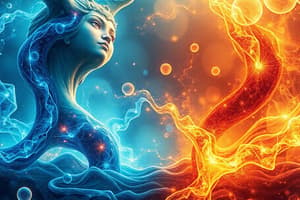Podcast
Questions and Answers
Which of the following is NOT a characteristic of an oxidation reaction?
Which of the following is NOT a characteristic of an oxidation reaction?
- Gain of electrons (correct)
- Removal of hydrogen
- Addition of oxygen
- Loss of electrons
In a redox reaction, the substance that gets oxidized acts as a reducing agent.
In a redox reaction, the substance that gets oxidized acts as a reducing agent.
True (A)
What is the name given to a chemical reaction where both oxidation and reduction occur simultaneously?
What is the name given to a chemical reaction where both oxidation and reduction occur simultaneously?
Redox reaction
The substance that ______ oxygen or loses hydrogen or donates electrons is called a reducing agent.
The substance that ______ oxygen or loses hydrogen or donates electrons is called a reducing agent.
Match the following examples with their corresponding type of reaction:
Match the following examples with their corresponding type of reaction:
Flashcards
Oxidation Reaction
Oxidation Reaction
A reaction involving addition of oxygen, removal of hydrogen, or loss of electrons.
Reduction Reaction
Reduction Reaction
A reaction involving removal of oxygen, addition of hydrogen, or gain of electrons.
Redox Reaction
Redox Reaction
A reaction where oxidation and reduction occur simultaneously.
Oxidizing Agents
Oxidizing Agents
Signup and view all the flashcards
Reducing Agents
Reducing Agents
Signup and view all the flashcards
Study Notes
Oxidation & Reduction
- Oxidation Reaction: A chemical reaction involving the addition of oxygen to a substance, the removal of hydrogen from a substance, or the loss of electrons from an atom.
- Reduction Reaction: A chemical reaction involving the removal of oxygen from a substance, the addition of hydrogen to a substance, or the gain of electrons by an atom.
- Redox Reaction: A reaction where oxidation and reduction occur simultaneously, involving the transfer of electrons between substances. Reactions involving the loss or gain of electrons are considered redox reactions.
Example of Oxidation
- 2Cu + O₂ → 2CuO: Addition of oxygen to copper.
- H₂S + Cl₂ → 2HCl + S: Removal of hydrogen from H₂S and addition of hydrogen to chlorine. Loss of electrons from H₂S and gain of electrons from chlorine.
- 2FeCl₂ + Cl₂ → 2FeCl₃: Gain of electrons by chlorine; transfer of electrons from Fe2+ to Cl₂.
Example of Reduction
- CuO + H₂ → Cu + H₂O: Removal of oxygen from CuO to form Cu and addition of hydrogen to CuO to form H₂O.
- Cl₂ + H₂S → 2HCl + S: Addition of hydrogen to chlorine, gain of electrons to form HCl; oxidation of hydrogen sulfide to form sulfur with loss of electrons.
- 2FeCl₃ + SO₂ + 2H₂O → 2FeCl₂ + 2HCl + H₂SO₄: Gain of electrons to become Fe2+ .
Oxidizing Agents
- Substances that lose oxygen or gain hydrogen or accept electrons.
- Examples include O₂, Cl₂, H₂O₂, conc. H₂SO₄, conc. HNO₃, MnO₂, PbO₂, Pb₃O₄, KNO₃.
Reducing Agents
- Substances that gain oxygen or lose hydrogen or donate electrons.
- Examples include H₂, CO, SO₂, H₂S, NH₃, HCl, metals (e.g., K, Na).
- The substance that gets reduced acts as an oxidizing agent, while the substance that gets oxidized acts as a reducing agent.
Studying That Suits You
Use AI to generate personalized quizzes and flashcards to suit your learning preferences.




